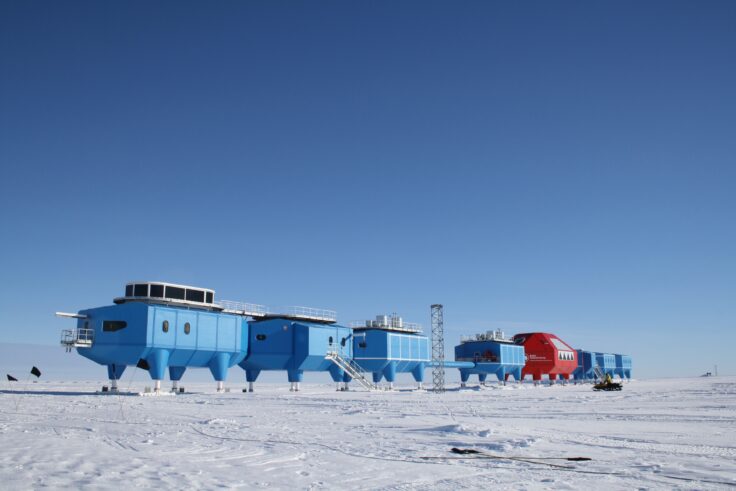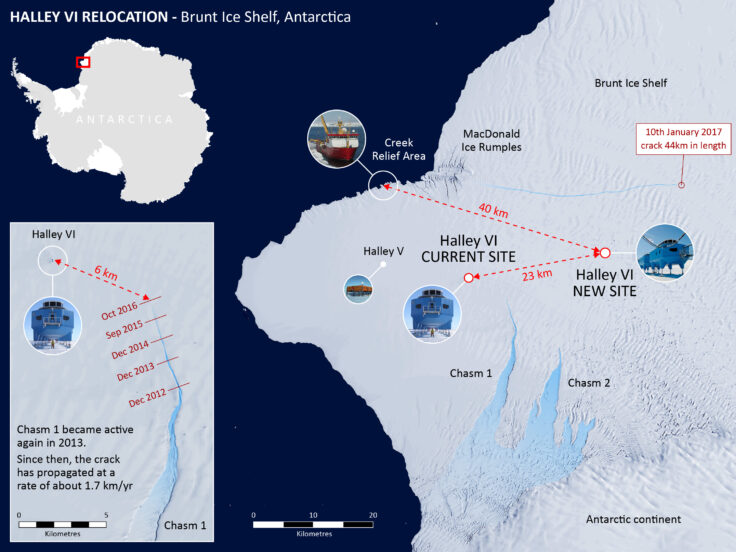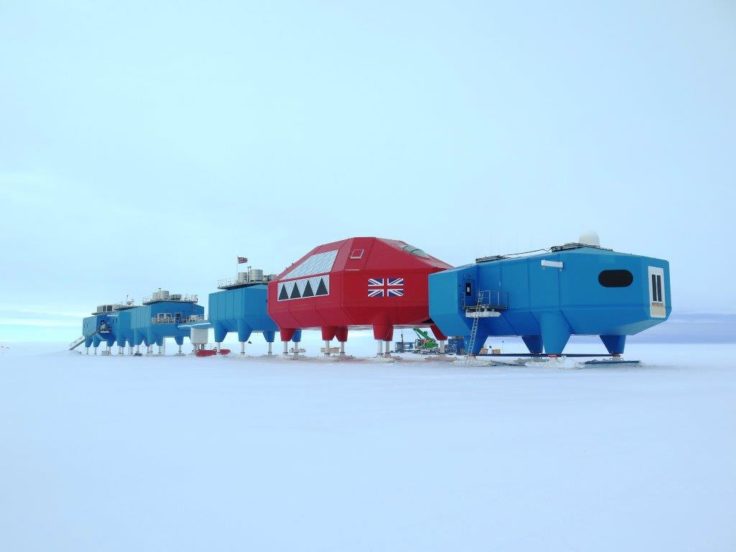Halley Research Station Antarctica to close for winter
British Antarctic Survey (BAS) has decided not to winter at Halley VI Research Station for safety reasons. The station, which is located on the floating Brunt Ice Shelf in Antarctica, will shut down between March and November 2017. Changes to the ice, particularly the growth of a new crack, presents a complex glaciological picture that means that BAS scientists are unable to predict with certainty what will happen to the ice shelf during the forthcoming Antarctic winter. As a precautionary measure BAS will remove its people before the Antarctic winter begins.
Halley VI station is in the final stages of being relocated 23 km from its present site to put it upstream of a previously dormant ice chasm that began to show signs of growth in 2012.

In October 2016, a second crack appeared some 17 km to the north of the research station. Since then glaciologists have monitored the growth of this crack using a network of GPS instruments that measure the deformation of the ice, together with European Space Agency satellite imagery, ground penetrating radar, and on-site drone footage, which show that the recent changes to the Brunt Ice Shelf have not been seen before. They have run computer models and created bathymetric maps to determine whether or not a large iceberg will calve, and the impact that could have on the remaining ice shelf. They conclude that they are unable to predict with certainty what will happen to the ice shelf during the forthcoming Antarctic winter and beyond.

There is no immediate risk to the people currently at the station, or to the station itself. However, there is sufficient uncertainty about what could happen to the ice during the coming Antarctic winter for BAS to change its operational plans. BAS is confident of mounting a fast uplift of personnel during summer months if a fracturing of the ice shelf occurred. However, access to Halley by ship or aircraft is extremely difficult during the winter months of 24-hour darkness, extremely low temperatures and the frozen sea. The Director of BAS has therefore decided that it is prudent for safety reasons to shut down the station as a precautionary measure and remove its people before the Antarctic winter begins. There are currently 88 people on station including summer-only staff working on the relocation project and 16 who were scheduled to over-winter.
Every effort is currently being made to ensure the continuity of long-term scientific data capture in these circumstances. Options to temporarily redeploy research and technical support teams to other parts of BAS are being explored.
Halley VI Research Station is an internationally important platform for global earth, atmospheric and space weather observation in a climate-sensitive zone. In 2013 the station attained the World Meteorological Organization (WMO) Global Atmosphere Watch (GAW) Global station status, becoming the 29th in the world and 3rd in Antarctica.
Director of Operations Captain Tim Stockings says,
“Halley VI Research Station sits on a floating ice shelf. It was designed specifically to move inland if required. The current work to relocate our station is going very well. This challenging engineering project is scheduled to complete as planned by early March 2017. We want to do the right thing for our people. Bringing them home for winter is a prudent precaution given the changes that our glaciologists have seen in the ice shelf in recent months. Our goal is to winterise the station and leave it ready for re-occupation as soon as possible after the Antarctic winter.”
ENDS
Issued by the Press Office at British Antarctic Survey.
Athena Dinar, Senior PR & Communications Manager, British Antarctic Survey, tel: +44 (0)1223 221 441; mobile: +44 (0)7909 008516; email: amdi@bas.ac.uk
Sarah Vincent, Senior Communications Manager, British Antarctic Survey: tel +44 (0)1223 221445; mobile +44 (0)7850 541910; email sarnce@bas.ac.uk
Notes to Editors:
For images and interview requests please contact the BAS Press Office
About Halley VI
Halley VI Research Station sits on Antarctica’s 150-m thick Brunt Ice Shelf. This floating ice shelf flows at a rate of 0.4 km per year west towards the sea where, at irregular intervals, it calves off as icebergs. Halley is crucial to studies into globally important issues such as the impact of extreme space weather events, climate change, and atmospheric phenomena. It was ozone measurements at Halley that led to the discovery of the Antarctic Ozone Hole in 1985 — they are now being used to evaluate its recovery.
Long-term monitoring of the natural changes that occur in the ice shelf has revealed changes, including recent growth of a chasm that was previously dormant for around 35 years. Preparatory work for the re-location was carried out during the 2015-16 Antarctic Summer season (Nov-March), and moving the station is almost complete. This involved uncoupling the 8 station modules and using large tractors to transport each module further inland.
There have been six Halley research stations on the Brunt Ice Shelf since 1956.
About closing the station for winter
Whilst BAS is confident of mounting a fast uplift of personnel during summer months if a fracturing of the ice shelf occurred the same cannot be said for winter.
Between now and early March science and technical teams will complete the relocation of the station modules and prepare them for winter and ready for recommissioning next season. Remote instruments will continue to capture and store data about movement of the ice shelf. A staged removal of summer-only personnel whose work on the relocation is complete is expected to begin in early-February. All remaining personnel are scheduled to leave by early March.
About Halley science
- Ozone measurements that have been made continuously at Halley since 1956 (which led to the discovery of the ozone hole), contribute to the WMO’s Earth Observation strategy for co-operation and integrated systems for monitoring of the atmosphere.
- Space weather data captured at Halley contributes to the Space Environment Impacts Expert Group that provides advice to Government on the impact of space weather on UK infrastructure and business.
- During recent winters, Halley has participated in a European Space Agency research experiment into prolonged human space flight. This project seeks to test how people can adapt to life in remote and isolated locations.
About the re-location project
- Halley Research Station is modular. Each module is being de-coupled from the others and towed across the ice by tractors
- In 2015/16 field season, glaciologists and operational teams conducted a survey to identify a new site for Halley Research Station which is located 23 km upstream on the Brunt Ice Shelf.
- The relocation project is being carried out over three years. Work began in 2015-16 with in-depth site surveys, detailed ice monitoring and initial preparations to de-couple the modules.
- During the 2016-17 Antarctic summer season temporary camps for housing the workforce were established and station modules and other infrastructure moved to the new site. These will be removed by the end of summer.
- Temporary containerised science facilities and accommodation units were set up to keep science projects going during winter.

Britain in Antarctica
- British Antarctic Survey’s Rothera Research Station is not affected by the Halley VI winter closure. Therefore, there will be a continuous UK Antarctic presence over this period. Bird Island and King Edward Point – the subantarctic stations operated on South Georgia – will continue to operate year-round also.
- The Government has an ongoing commitment to Antarctic science and UK presence in the region.